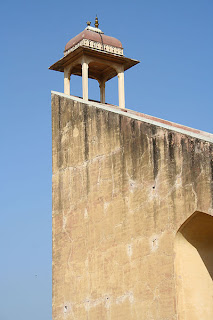Jantar Mantar (Jaipur)
The Jantar
Mantar is a collection of architectural astronomical instruments, built by Maharaja (King) Jai Singh II at his then new capital of Jaipur between 1727 and 1734. It is modeled after the
one that he had built for him at the Mughal capital of Delhi.
He had constructed a total of five such facilities at different locations,
including the ones at Delhi and Jaipur. The Jaipur observatory is the largest
and best preserved of these. It has been inscribed on the World Heritage List
as "an expression of the astronomical skills and cosmological concepts of
the court of a scholarly prince at the end of the Mughal period".[1] Early restoration work was
undertaken under the supervision of Major Arthur Garrett, a
keen amateur astronomer, during his appointment as Assistant State Engineer for
the Jaipur District.
Name
The name is derived from jantar ("instrument"), and Mantar
("formula", or in this context "calculation"). Therefore jantar
mantar means literally 'calculation instrument'. This observatory has
religious significance, since ancient Indian astronomers were also Jyotisa masters.
Description
The observatory consists of fourteen major geometric
devices for measuring time, predicting eclipses, tracking stars' location as
the earth orbits around the sun, ascertaining the declinations of planets, and
determining the celestial altitudes and related ephemerides. Each is a fixed
and 'focused' tool. The Samrat Yantra, the largest instrument, is 90 feet
(27 m) high, its shadow carefully plotted to tell the time of day. Its
face is angled at 27 degrees, the latitude of Jaipur. The Hindu chhatri (small
cupola) on top is used as a platform for announcing eclipses and the arrival of
monsoons.
Built from local stone and marble, each instrument carries an astronomical
scale, generally marked on the marble inner lining. Bronze tablets, all
extraordinarily accurate, were also employed. Thoroughly restored in 1901, the
Jantar Mantar was declared a national monument in 1948.
An excursion through Jai Singh's Jantar is a unique experience of walking
through solid geometry and encountering a collective astronomical system
designed to probe the heavens.
The instruments are in most cases huge structures. The scale to which they
have been built has been alleged to increase their accuracy. However, the
penumbra of the sun can be as wide as 30 mm, making the 1mm increments of
the Samrat Yantra sundial devoid of any practical significance. Additionally,
the masons constructing the instruments had insufficient experience with
construction of this scale, and subsidence of the foundations has subsequently
misaligned them. The samrat yantra, for instance, which is a sundial, can be used to tell the time to an
accuracy of about two seconds in Jaipur local time. The Giant Sundial, known as the Samrat
Yantra (The Supreme Instrument) is the world's largest sundial, standing 27 meters tall. Its shadow moves
visibly at 1 mm per second, or roughly a hand's breadth (6 cm) every
minute, which can be a profound experience.
Today the observatory is a popular tourist attraction. However, local
astronomers still use it to predict the weather for farmers, although their
authority is becoming increasingly questionable. Students of astronomy and
Vedic astrology are required to take some of their lessons at the observatory,
and it can be said that the observatory is the single most representative work
of Vedic thought that still survives, apart from the texts. Many of the smaller
instruments display remarkable innovation in architectural design and its
relation to function, for instance - the Ram Yantra.








Jantar Mantar is an Historical place which is just an amazing mixture of Astronomy and Astrology, using mathematics, though typically rated as an astronomical observatory. I think it is a great attraction. Walking distance from City Palace and aesthetically interesting, it's a terrific stop while in Jaipur.
ReplyDelete